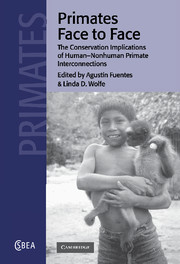Book contents
- Frontmatter
- Contents
- List of contributors
- Foreword
- Acknowledgements
- Introduction
- Part 1 Science and nonhuman primates
- 1 Anthropology and primatology
- 2 Resistance to the cross-species perspective in anthropology
- 3 The ethics and efficacy of biomedical research in chimpanzees with special regard to HIV research
- Part 2 Cultural views of nonhuman primates
- Part 3 Conservation of nonhuman primates
- Part 4 Government actions, local economies and nonhuman primates
- Index
3 - The ethics and efficacy of biomedical research in chimpanzees with special regard to HIV research
Published online by Cambridge University Press: 20 October 2009
- Frontmatter
- Contents
- List of contributors
- Foreword
- Acknowledgements
- Introduction
- Part 1 Science and nonhuman primates
- 1 Anthropology and primatology
- 2 Resistance to the cross-species perspective in anthropology
- 3 The ethics and efficacy of biomedical research in chimpanzees with special regard to HIV research
- Part 2 Cultural views of nonhuman primates
- Part 3 Conservation of nonhuman primates
- Part 4 Government actions, local economies and nonhuman primates
- Index
Summary
Among our fellow animals the chimpanzee is the species that most closely resembles ours biologically, behaviorally, and cognitively. At the biological level, the biochemical and genetic similarities are especially profound since chimpanzee beings are closer to human than to gorilla beings (King and Wilson, 1975; Lewin, 1984; Gibbons, 1990). King and Wilson (1975) were so struck by the similarity between chimpanzee and human that they referred to them as our ‘sibling species’.
As the work of Jane Goodall (1986), and others like her, has shown, the behavior of the wild chimpanzee is just as strikingly similar to our own as are its biochemistry and genetics. Free-living chimpanzees in Africa as hominids are not so different from humans. They live in communities, they hunt, mothers care for their children and children care for their mothers, they use and make tools, and perhaps most important of all they can suffer from emotional as well as physical pain. Like human groups, there are also cultural differences between free-living chimpanzee communities; some medicate themselves with medicinal plants, others do not; some use hammers and anvils, others do not; in fact, some communities have never been observed to make or use any tools at all; and there are gestural dialects between different communities (McGrew, 1992).
- Type
- Chapter
- Information
- Primates Face to FaceThe Conservation Implications of Human-nonhuman Primate Interconnections, pp. 45 - 60Publisher: Cambridge University PressPrint publication year: 2002



